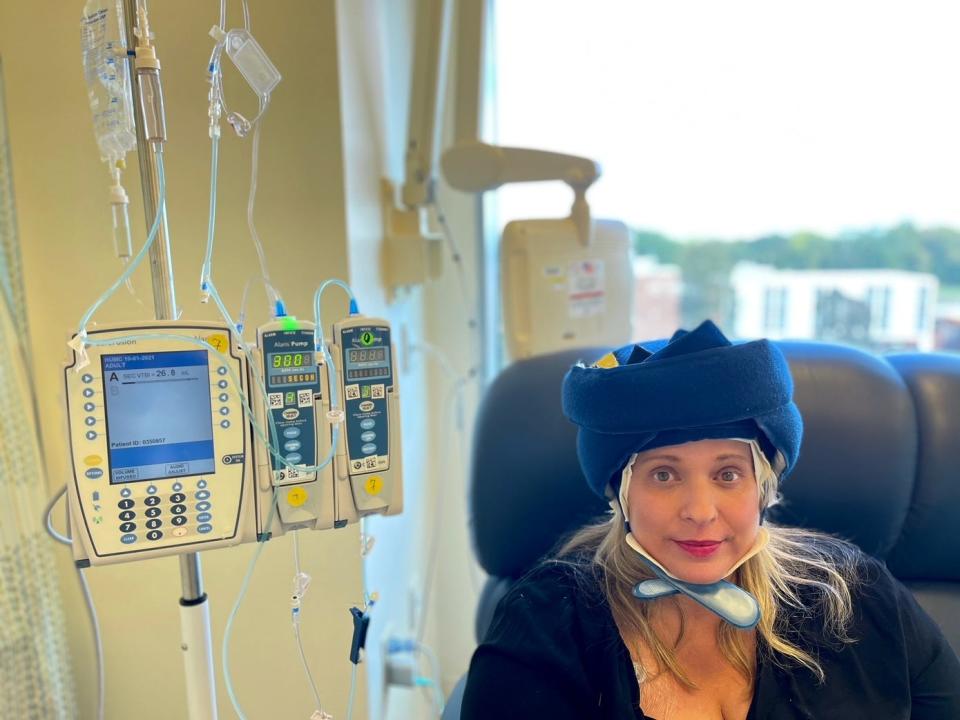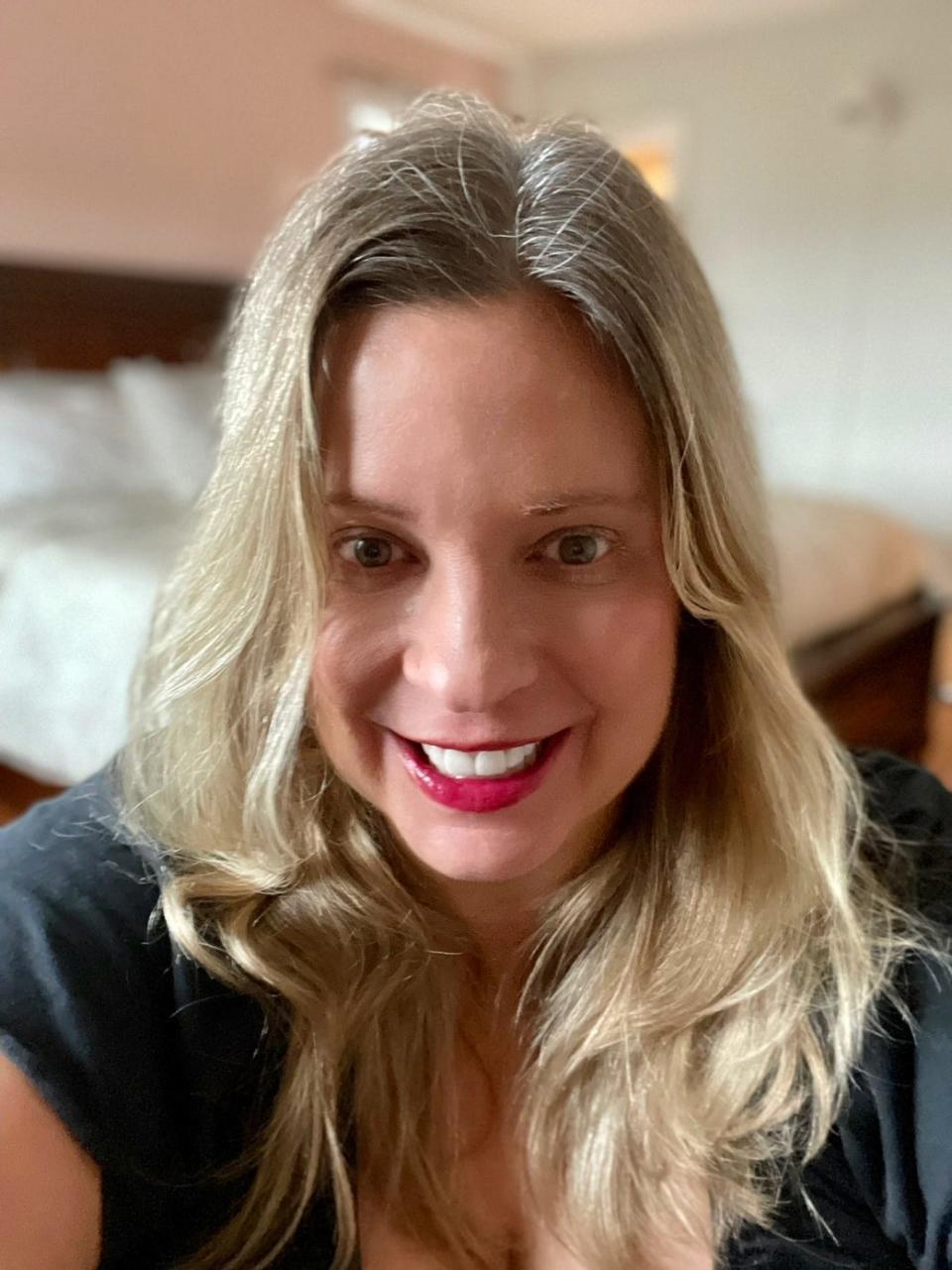Breast cancer patients say 'cold capping' saved their hair. What is it and why aren't more people doing it?
It took four years for Nikki Cox to grow her hair back to its original length after she was diagnosed with breast cancer in 2016.
During those years, Cox, a 35-year-old from Aliquippa, Pennsylvania, was reminded of her battle every day when she looked in the mirror, tied on a scarf or scratched at her itchy wig.
Cox had just begun to close that ugly chapter of her life when she was diagnosed with breast cancer again in May 2020.
This time, she was determined to salvage her hair.
“My hair was an important part of my healing and mental health,” she said. “I wanted to feel good on the outside knowing what I was going through on the inside.”
She decided to try scalp-cooling therapy after finding a flyer hidden between the stack of papers she received from her oncologist. By the end of her recent treatment, Cox had saved 90-95% of her hair.
“The whole time I was in treatment, I never wore a wig. I never had to wear a scarf,” Cox said. “I didn’t look like what I was going through.”

Scalp cooling therapy – also known as cold capping – is available to all cancer patients except those battling leukemia or certain other blood-related cancers, but health experts say many people don’t know the option exists. And for those familiar with the process, the high cost and spotty insurance coverage can put the option out of reach.
Cancer patients, survivors and advocates want to create more awareness about scalp cooling therapy and the effect hair has on a patient’s mental health, emotional health and their recovery process. As more people learn about cold capping, they hope more insurance companies will see the value in providing coverage or reimbursement.
“We cringe every time we get an email saying, ‘I just had my first chemo treatment and heard about cold caps – is it too late to save my hair?’ Sadly, it is too late," said Nancy Marshall, co-founder of the The Rapunzel Project, a non-profit promoting cold capping awareness.
During scalp-cooling therapy, the patient wears a special cap strapped to their head before, during and after chemotherapy sessions to keep the head cold and prevent the harsh chemo from getting to the hair follicles.
“The way chemo works is that it tries to kill off cancer cells and at the same time some of it kills healthy cells, especially those that turn over faster like your hair,” said Dr. Lynn Jeffers, past president of the American Society of Plastic Surgeons and medical director of Dignity Health’s Integrated Breast Center at St. John’s Camarillo Hospital. “If you slow down the metabolism of your hair with the cold … those cells that you slowed down don’t take up the chemo as much.”
'A battle on its own': Shannen Doherty opens up about hair loss during her cancer treatment
Cox used a scalp-cooling system by a company called Dignitana, which was offered through her hospital and regulates the cap’s temperature through a machine. The company’s product, DigniCap, has been cleared by the Food and Drug Administration, with studies showing it is 67% effective at saving at least 50% of patients’ hair.
"A study was done that found 8% of women forgo chemo out of fear of hair loss," said Dignitana spokesperson Melissa Bourestom. "That’s a very scary statistic to us because, of course, the most important thing is that you're treating your cancer."
Other patients opt for manual scalp cooling, offered by companies such as Penguin, in which head caps submerged in dry ice are strapped onto the patient’s head and replaced every 20 minutes by a friend, family member or professional “cold capper.”
Dannielle Leigh hired a “cold capper” through Right Arm Inc. when she was diagnosed with breast cancer during the COVID-19 pandemic and couldn’t bring friends or family members into the infusion center.

“It was a complete support system … to have somebody there saving my hair and doing all the things that my boyfriend or my mom would have done,” said Leigh, a New Jersey resident. “That wasn’t part of my decision, but looking back now that was a great thing for me because I wasn’t alone.”
Cox and Leigh found success in cold capping, but health experts warn saving hair is never guaranteed, especially among patients undergoing particularly harsh chemotherapy. It’s also a time-consuming, labor intensive and uncomfortable process.
But for many women, it’s worth the gamble.
“Having control over something felt really, really good,” Leigh said. “I couldn’t control the fact that I had a cancer diagnosis, I couldn’t control that my life was being turned upside down, but I could control the fact that I was keeping my hair.”
Cox was getting married during treatment and wanted to feel like a traditional bride on her wedding day. Her children were younger when she was first diagnosed with breast cancer in 2016, but are old enough now to understand what her second diagnosis meant.
“My family has been through so much with my diagnosis and I didn’t wanted them to associate cancer with baldness or death,” she said. “I would do whatever I could do to make myself look as normal as possible so it would be less traumatizing to them.”
Scalp-cooling therapy, however, is expensive. Patients pay to buy or rent the cooling cap and to use the machine each chemotherapy session, which can average a dozen times depending on the cancer type and severity.
For manual cool capping, patients are responsible for the dry ice as well as training costs for a loved one to replace the cap. If they don’t have someone available to do the job, a professional cold capper can cost around $300 per session.
Leigh said her total bill was $8,000. She plans to seek reimbursement from her insurance company.
Is it a war or a journey?: Characterizing cancer as a 'war' assumes it can be won. Is that too simple?

“Maybe I’ll have a shot at getting some money back, but even if I didn’t and I had to do it all over again, I would definitely still do it,” she said. “I got to keep some dignity that normally I don’t think I would be able to do … That’s worth a lot.”
Some patients have said they've paid as little as $1,800 for the entire service. Insurance is more likely to cover the machine scalp cooling systems compared to the manual cold caps, Marshall said.
Although some insurance companies are improving coverage and reimbursement, many patients have to fight to get it. Overwhelmed with other medical expenses, people frequently become too tired to haggle with insurance companies and end up dropping the claim.
The Rapunzel Project provides a list of diagnostic codes patients can give to their insurance company. The codes can help, but Marshall said coverage is inconsistent and often only apply to the cold cap rentals.
“It is an inefficient and unnecessarily expensive system,” she said. “Chemo-induced hair loss, or chemo induced alopecia, is a devastating side effect of treating cancer. Patients deserve financial support to cope or prevent CIA.”
Follow Adrianna Rodriguez on Twitter: @AdriannaUSAT.
Health and patient safety coverage at USA TODAY is made possible in part by a grant from the Masimo Foundation for Ethics, Innovation and Competition in Healthcare. The Masimo Foundation does not provide editorial input.
This article originally appeared on USA TODAY: Breast cancer, chemo hair loss: Cold capping, scalp cooling can help
